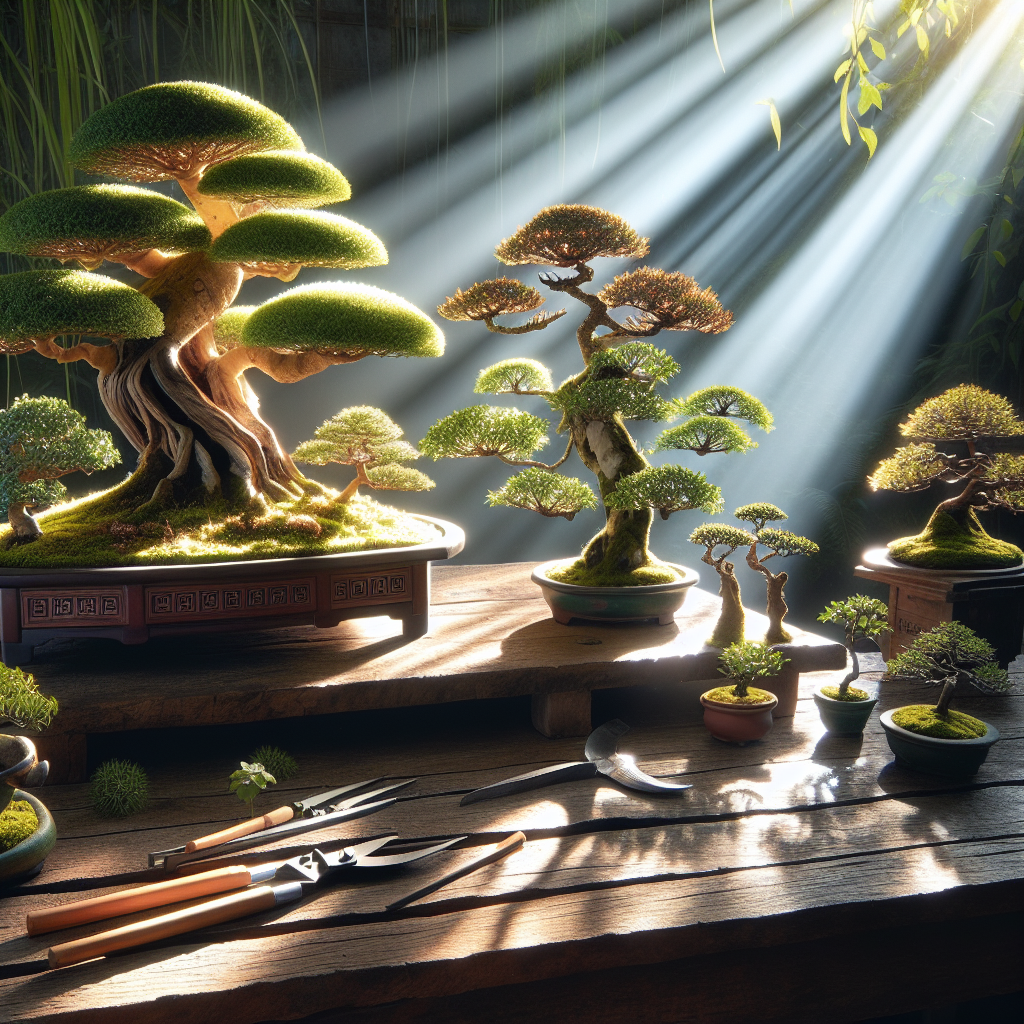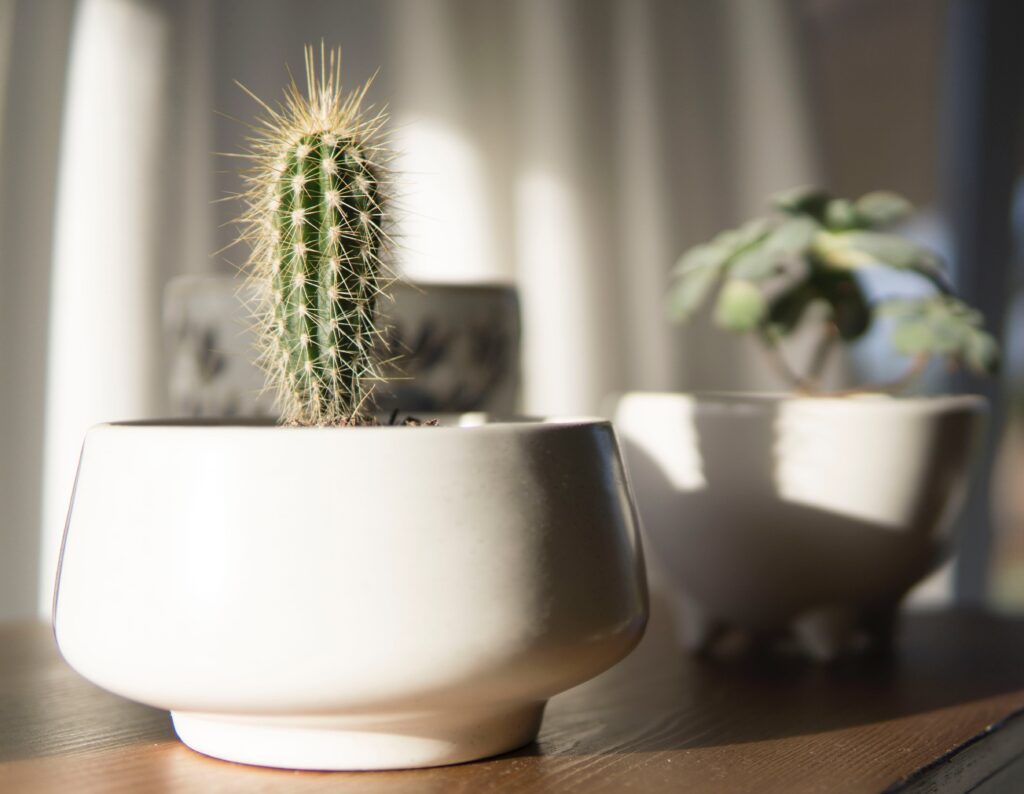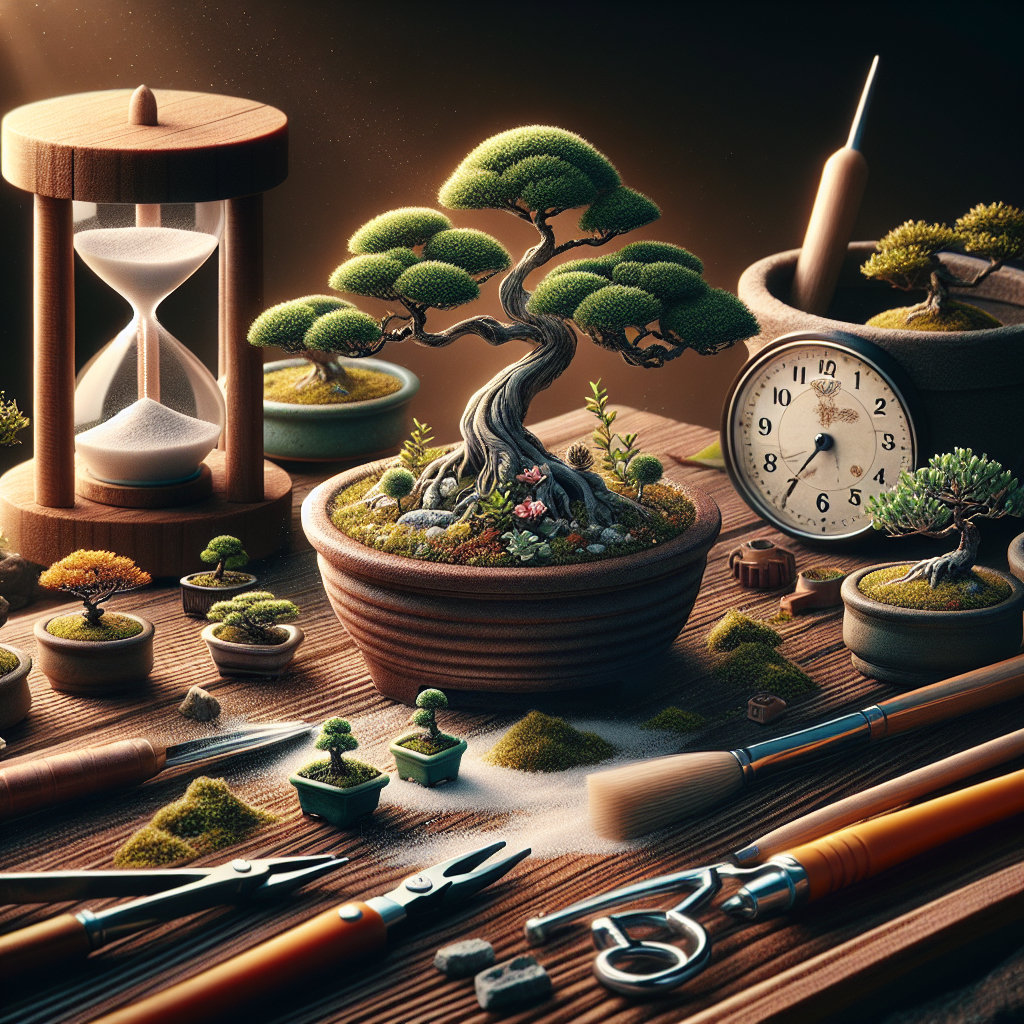
Have you ever wondered if investing in a bonsai tree is truly worth it? With their delicate beauty and unique charm, bonsai trees have captured the hearts of many plant enthusiasts. In this article, we will explore the value and benefits of owning a bonsai tree, helping you decide whether these miniature wonders are truly worth the time, effort, and investment they require. So, grab a cup of tea and join us as we unravel the captivating world of bonsai trees!

Benefits of Bonsai Trees
Enhance Aesthetics
Bonsai trees are a beautiful and captivating addition to any space. With their intricate branches, delicate leaves, and impressive asymmetry, they add a touch of elegance and sophistication to your home or garden. The art of bonsai emphasizes creating a miniature representation of a full-sized tree, making each bonsai tree a unique masterpiece. Whether styled in a traditional form or a more contemporary design, bonsai trees are sure to enhance the aesthetics of any space.
Stress Relief
In today’s fast-paced world, finding ways to unwind and relax is essential for our mental well-being. Bonsai trees offer a therapeutic escape from the daily stressors of life. Engaging with these miniature trees can help to reduce anxiety, promote mindfulness, and increase overall feelings of tranquility. Taking care of a bonsai tree requires concentration and focus, allowing you to forget about your worries and immerse yourself in the present moment. The gentle act of pruning and shaping the tree can be both a mindful practice and a form of creative expression.
Developing Patience and Discipline
Bonsai cultivation is a long-term endeavor that requires unwavering patience and discipline. These miniature trees grow at a much slower pace compared to their full-sized counterparts, teaching us the importance of patience and perseverance. Through careful observation and meticulous care, you will witness the gradual transformation of your bonsai tree over time. This process instills a sense of discipline and dedication, as you learn to prioritize the needs of your bonsai tree and adjust your routines accordingly. The journey of nurturing a bonsai tree cultivates valuable character traits that can be applied to various aspects of life.
Types of Bonsai Trees
Indoor Bonsai Trees
Indoor bonsai trees are specifically selected and cultivated to thrive in an indoor environment. They are typically species that can tolerate lower light levels and drier conditions. Jade, Ficus, and Chinese Elm are popular choices for indoor bonsai trees. These trees bring the allure of nature into your living space, creating a calming and visually appealing ambiance.
Outdoor Bonsai Trees
Outdoor bonsai trees, also known as garden bonsai, are varieties that are well-suited for outdoor cultivation. They require exposure to natural sunlight and the seasonal changes that come with it. Junipers, Pines, and Maples are common choices for outdoor bonsai trees. These trees can be displayed in your garden or on a balcony, adding a touch of natural beauty to your outdoor living space.
Factors to Consider
Time Commitment
Bonsai cultivation is a long-term commitment that requires consistent care and attention. Just like any living thing, bonsai trees need regular watering, pruning, and maintenance. Depending on the type of tree and its growth rate, the amount of time spent on bonsai care may vary. If you have a busy schedule or frequently travel, it’s important to consider the time commitment required before embarking on your bonsai journey.
Costs
While bonsai trees can be an affordable hobby, there are certain costs to consider. The initial investment includes purchasing a healthy tree, appropriate tools, pots, and soil. Ongoing costs may include fertilizers, pesticides, and potential professional assistance for specialized pruning or styling. It’s essential to budget accordingly and consider the financial commitment involved in the long-term care of your bonsai tree.
Space Requirements
Bonsai trees come in various sizes, ranging from a few inches to several feet in height. Before bringing a bonsai tree into your home or garden, consider the space you have available. Smaller bonsai trees are more suitable for indoor cultivation, while larger outdoor bonsai trees require ample space to grow and thrive. It’s vital to choose a location that provides adequate light, airflow, and protection from extreme weather conditions.
The Art of Bonsai
Cultivating a Miniature Tree
Bonsai cultivation is not simply about keeping a small tree in a pot; it is an art form that requires meticulous care and skill. The art of bonsai involves trimming and sculpting the tree to mimic the grandeur and beauty of a full-sized tree, while maintaining balance and harmony. Each branch, leaf, and curve is carefully considered and shaped to create a visually appealing and harmonious composition. The process of cultivating a miniature tree allows you to connect with nature on a deeper level and express your creativity.
Styles and Techniques
Bonsai offers a wide range of styles and techniques to explore. From traditional forms like formal upright, informal upright, and cascade, to more contemporary styles such as windswept or forest planting, the possibilities are endless. Each style requires different techniques in wiring, pruning, and shaping to achieve the desired visual effect. The art of bonsai opens a world of creativity and experimentation, allowing you to develop your own unique style as you gain experience and knowledge.

Bonsai Tree Care
Watering
Proper watering is crucial for the health and vitality of your bonsai tree. It’s essential to strike a balance between underwatering and overwatering. The frequency of watering depends on factors such as the type of tree, size of the pot, and environmental conditions. Regularly check the moisture level of the soil and adjust your watering schedule accordingly. It’s important to avoid letting the soil dry out completely or become waterlogged, as both scenarios can harm the roots and compromise the overall health of the tree.
Fertilization
To ensure the optimal growth and development of your bonsai tree, regular fertilization is necessary. Bonsai trees require a well-balanced fertilizer that provides essential nutrients. Slow-release or liquid fertilizers specifically formulated for bonsai trees can be used. The frequency and concentration of fertilization depend on the type of tree and the time of year. It’s crucial to follow the instructions provided by the fertilizer manufacturer and monitor the response of your bonsai tree to adjust the feeding regimen accordingly.
Pruning
Pruning is one of the fundamental techniques in bonsai care. It involves selectively removing branches, leaves, and shoots to maintain the desired shape and encourage ramification. Pruning not only helps to shape the tree aesthetically but also promotes vigorous growth. It’s important to prune with precision, using sharp and sterilized tools to minimize stress and prevent infections. Regular pruning sessions, usually conducted during the dormant or growing season depending on the tree species, are necessary to maintain the health and appearance of your bonsai tree.
Repotting
Repotting is an essential aspect of bonsai tree care that ensures the longevity and development of your tree. It involves transferring the tree to a new pot with fresh soil, promoting root health and preventing the tree from becoming root-bound. The frequency of repotting varies depending on the age and growth rate of the tree. It’s generally recommended to repot younger trees every one to three years, while older trees may require repotting every three to five years. Careful and gentle handling of the roots during repotting is crucial to prevent damage and ensure the tree’s vitality.
Common Challenges
Pest and Disease Management
Like any other plants, bonsai trees are susceptible to pests and diseases. Common pests include aphids, spider mites, and scale insects, which can cause damage to the leaves and stems of your tree. Regular inspection and prompt action are essential to prevent infestations and mitigate the risk of damage. Additionally, proper sanitation, good air circulation, and providing a healthy growing environment can help minimize the risk of pests and diseases. If you encounter significant pest or disease issues, consulting with a professional or seeking guidance from experienced bonsai enthusiasts can be beneficial.
Environmental Factors
The environment in which your bonsai tree is grown plays a vital role in its overall health and development. Factors such as temperature, humidity, light exposure, and air quality can impact the well-being of your tree. It’s important to understand the specific requirements of your bonsai tree species and ensure it is provided with the necessary conditions for optimal growth. Extreme temperatures, excessive sunlight, or prolonged exposure to drafts can cause stress and damage to your tree. Monitoring environmental factors and making adjustments accordingly will contribute to the success and longevity of your bonsai tree.

History and Cultural Significance
Ancient Origins
The art of bonsai originated in ancient China over a thousand years ago. Initially, bonsai was primarily practiced by Buddhist monks as a form of meditation and reverence for nature. The art form eventually made its way to Japan, where it gained immense popularity and evolved into a distinct Japanese art form. Over time, bonsai has become intertwined with culture and tradition, symbolizing harmony, balance, and the transient nature of life.
Japanese Influence
Japan has played a significant role in the development and popularization of bonsai. The intricate and refined techniques of Japanese bonsai masters have been passed down through generations, shaping the art form into what it is today. Japanese gardens often feature exquisite bonsai displays, showcasing the harmony between nature and human ingenuity. The Japanese aesthetic values of simplicity, asymmetry, and reverence for nature are deeply ingrained in the art of bonsai.
Symbolism and Spirituality
Bonsai has profound symbolism and spiritual significance. The act of cultivating a miniature tree represents our connection with nature and the cycle of life. The art form teaches us to appreciate the beauty of imperfection, as bonsai trees often exhibit irregularities and asymmetry. Bonsai is also considered a symbol of patience, resilience, and the potential for personal growth. The visual representation of an ancient tree in miniature form carries a sense of wisdom and timelessness.
Satisfaction and Rewards
Creating Living Art
The process of transforming a regular tree into a miniature work of art is incredibly rewarding. Witnessing the growth and development of your bonsai tree over time fills you with a sense of accomplishment and pride. Each manipulation and styling decision contributes to creating a unique piece of living art that reflects your vision and creativity. The satisfaction of being able to admire and share your bonsai tree with others is unparalleled.
Sense of Accomplishment
Bonsai cultivation requires dedication, continuous learning, and the ability to adapt. As you acquire knowledge and hone your skills, you will notice improvements in your tree’s health, shape, and overall aesthetic appeal. The ability to successfully care for and shape a living organism instills a sense of accomplishment and personal growth. Bonsai provides a tangible representation of your efforts and serves as a reminder of the rewards that come with patience and perseverance.
Connecting with Nature
In a world that increasingly disconnects us from nature, bonsai provides an opportunity to reconnect with the natural world on a profound level. Caring for a bonsai tree allows you to observe the subtle nuances of growth, the changing seasons, and the intricate beauty of nature’s design. The act of tending to a bonsai tree nurtures an appreciation for the environment and cultivates a deeper understanding of the interconnectedness of life. Bonsai offers a chance to slow down, reflect, and connect with the natural rhythms and cycles that often go unnoticed in our busy lives.

Community and Collaboration
Bonsai Clubs and Associations
Engaging with fellow bonsai enthusiasts is an excellent way to expand your knowledge, share experiences, and learn from others. Joining a local bonsai club or association provides opportunities to attend workshops, demonstrations, and lectures by experienced practitioners. The supportive and collaborative nature of these communities fosters growth and camaraderie among bonsai enthusiasts. Connecting with like-minded individuals who share your passion for bonsai adds depth and enrichment to your bonsai journey.
Exhibitions and Competitions
Bonsai exhibitions and competitions offer a platform to showcase your bonsai trees and appreciate the beauty of others’ creations. These events provide opportunities to meet renowned bonsai artists, gain inspiration, and receive valuable feedback from judges and fellow enthusiasts. Exhibiting your bonsai tree not only allows you to share your artistic expression but also serves as a motivation to refine your skills and continue honing your craft. Attending exhibitions and competitions offers a rich and immersive experience that fuels your passion for bonsai.
Potential Drawbacks
Initial Learning Curve
Embarking on the bonsai journey requires a commitment to learning and acquiring knowledge about the specific needs of different tree species, proper care techniques, and artistic principles. Initially, it may seem overwhelming, and mistakes are inevitable. However, with time and experience, you will become more proficient and confident in your skills. Embracing the learning process and seeking guidance from experienced bonsai enthusiasts can help minimize these challenges.
Risk of Failure
Bonsai cultivation can be challenging, and even with the best care, trees can fail to thrive or succumb to various issues. Factors such as improper care, inadequate environment, or unforeseen pests or diseases can impact the health and survival of your bonsai tree. Dealing with such setbacks can be disheartening, especially when you have invested time and effort in its care. However, viewing failures as opportunities for learning and growth is essential in the bonsai journey.
Long-term Commitment
Bonsai is not a short-term or temporary hobby. It requires a long-term commitment and dedication to the continuous care and refinement of your trees. Bonsai trees can live for decades or even centuries with proper care, which means you will need to make arrangements for their ongoing maintenance and care if you are unable to tend to them yourself. Before starting your bonsai journey, consider the long-term commitment involved and ensure it aligns with your lifestyle and future plans.
In conclusion, the benefits of bonsai trees are plentiful, ranging from enhancing aesthetics to providing stress relief, and developing patience and discipline. With a wide variety of bonsai tree types, factors to consider, and techniques to master, bonsai offers a vast and captivating world to explore. Despite the potential challenges and long-term commitment, the satisfaction and rewards that come with cultivating living art, connecting with nature, and engaging with a supportive community make bonsai trees truly worth it. So why not embark on this enchanting journey and bring the beauty of bonsai into your life?
